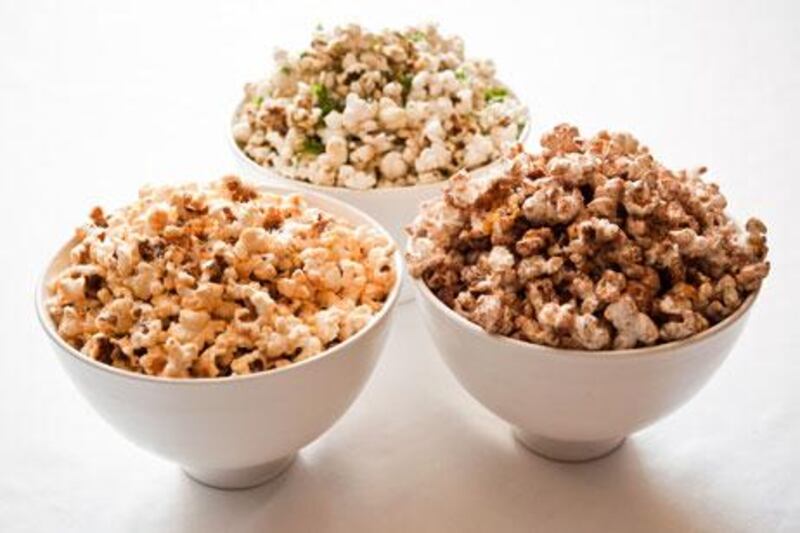Popcorn has been a staple part of cinema food for more than a century, but it's not always healthy. Emily Shardlow has some tips for tasty, low-fat popcorn and finds out what the celebrities are snacking on at the Abu Dhabi Film Festival
The temporary 1,200-capacity beach cinema at the Fairmont Bab Al Bahr offers a film experience with a difference: an alfresco atmosphere, waterside location and the sight of the Sheikh Zayed Grand Mosque looming in the background. Yet while the spectacular setting may be a far cry from the average shopping mall multiplex, this doesn't mean visitors have to do without their favourite movie munchies. The stalwarts of cinema snacking - popcorn, nachos, soft drinks and sweets - are all available for purchase.
Of course, visitors expect nothing less. In countries across the world, a trip to the cinema has long been synonymous with splurging on a supersized treat and yet, when you think about it, the idea is actually a rather strange one. Who hasn't at some point started to feel more than a little irritated at the rustling of sweet wrappers or the incessant chomping of chocolate coming from a fellow theatre goer? Similarly, if you slurp away on a large soft drink as the opening credits roll, it's more than likely that mid-way through the film, just as things start to get interesting, you'll be battling the urge to visit the bathroom. While nachos dripping with gloopy orange cheese and pick 'n' mix sweets have their fans, popcorn tops the list of favourite film fodder. Eating puffed-up kernels of corn is nothing new: ears of popcorn found in the Bat Cave of west central New Mexico in 1948 and 1950 are believed to be some 4,000 years old and it is thought that the primary use of this corn was for popping.
The first mobile popcorn machine was invented by Charles Cretors in 1885 and proved to be a revelation for popcorn vendors. Before then their stationary status had proved limiting, but once the popcorn machines were mobile, they were able to hawk their wares at every large public gathering - fairs, rallies, sporting events and carnivals - and thus sales grew.
While the enticing smell and buttery flavour of freshly popped corn certainly helped attract customers, so too did the comparatively cheap prices. This also meant that unlike most other businesses, the popcorn industry flourished during the Great Depression, with popcorn viewed as an affordable luxury, thanks to its low cost (5-10 cents a bag/ Dh0.18-0.36).
As the first nickelodeon (dime) movie theatres opened in America in the early 1900s, so the popularity of popcorn grew. At this point, concession stands were banned from the cinemas themselves, but entrepreneurial popcorn and peanut vendors set up shop just outside and sold goods from there. By the 1930s, theatre owners had realised that selling snacks in-house was a fiscally savvy move and set up their own food stalls. This still holds true today; the National Association of Theatre Owners estimate that in the US, sales from concessions account for 40 per cent of theatres net revenue.
While its status as a much-loved cinema snack is undisputed, is puffed-up corn actually good for us? In short, it depends on how you treat those kernels.
In 2009, a report published by the Center for Science in the Public Interest shocked readers when it revealed that a number of American cinema chains cooked their corn in coconut oil (90 per cent saturated fat), before coating it with butter or margarine for flavour. The article "BIG: Movie Theaters Fill Buckets...and Bellies" found that a medium-sized bucket of popcorn purchased from the Regal Cinema chain in America contained 1,200 calories, 60g of saturated fat and 980mg of salt. The same sort of statistics were reflected at both AMC and Cinemark cinemas.
Cooked the right way, though - either in an air popping machine or on the hob in a couple of tablespoons of oil - popcorn can be considered a low-calorie, high-fibre, wholegrain snack, which contains traces of vitamins B and E and has a low GI. For this reason alone, it is well worth making popcorn at home. The three serving suggestions below add plenty of flavour to the corn, minus the worrying calories and saturated fat.
Healthy popcorn with three different toppings:
For the popcorn:
75g popcorn kernels
2 tbsp groundnut oil
Place a large saucepan over a high heat. Once hot, add the groundnut oil, followed a minute later by the popcorn. Stir well to coat the popcorn in the oil. Cover with a lid. After a minute or two you should hear the popping start. Shake the pan a couple of times and when the popping stops, remove from the heat and flavour with your chosen topping.
Any leftover popcorn can be stored in an airtight container for two to three days.
Lemon, chilli and Parmesan popcorn:
35g Parmesan, finely grated
tsp chilli powder
1 lemon, zest only
black pepper
Mix the Parmesan, chilli powder, lemon zest and a couple of twists of black pepper together and pour over the popcorn when it is still warm, stirring well to mix.
Cocoa and orange zest popcorn:
2 tbsp caster sugar
2 tsp good-quality cocoa powder
1 orange, zest only
Sieve together the caster sugar and cocoa powder, then stir in the orange zest.
As soon as the corn stops popping, remove the pan from the heat and sprinkle over the cocoa and sugar mixture. Stir well, until the popcorn is well coated and the sugar has started to melt. Leave to cool for a few minutes before serving.
Za'atar popcorn with coriander
1 tsp za'atar
small bunch coriander, leaves picked and chopped
black pepper
Add the za'atar to the pan containing the groundnut oil, before adding the popcorn kernels. Stir well to coat and cook as normal.
Remove the pan from the heat, sprinkle over the chopped coriander leaves and a few twists of black pepper.






